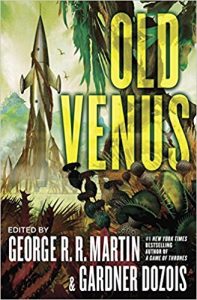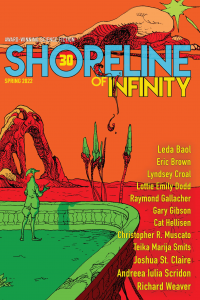Russell Letson reviews Old Venus
Old Venus, a companion volume to last year’s Old Mars, again offers stories set on a version of the titular planet that no longer matches what science tells us about it. In the introduction, co-editor Gardner Dozois writes that he and George R.R. Martin were looking for a return to the ‘‘heyday of the Planetary Romance,’’ when ‘‘the solar system swarmed with alien races and civilizations, as crowded and chummy as an Elks picnic.’’ But in 1962, everybody’s fun with Venus was spoiled when information from the Mariner 2 spacecraft revealed that the real planet was not the home of tropical jungles and swamps, big lizards, lost temples, and sexy aliens, but a lifeless hellhole of heat, toxic chemicals, and crushing pressures, ‘‘duller than a supermarket parking lot.’’ These 16 stories, mostly of novelette length, aspire to resuscitate not only the obsolete, imaginary planetology of Old Venus, but the iconography and tropes that filled the pulp adventure stories once set there: the rain-soaked frontier outback where questionable characters meet in roughneck saloons before setting out to find abandoned temples or lost cities, guided or preyed upon by aquatic or amphibious natives, pursued by hungry local fauna, and perhaps tempted by exotic-erotic possibilities.
Venus is a tougher planet to re-imagine as a usable setting than is Mars, and part of the fun of these stories is noting the ways the collection’s participants refurbish the old setting as a story-space that contemporary SF readers will accept. The writers take a variety of approaches to this end, and the enabling devices are ingenious and often powerfully transformative: time travel, alternate history, far-future terraforming, and panspermia. Then there’s the brute-force option: no disbelief-suspending fig-leaves, just a naked assertion that Venus is the swampy, cloud-shrouded tropical jungle of the pulps, so the story can roll on without any worries about pesky counterfactuality.
On the motif-and-trope side, the one most often employed is the trek into the interior. Allen Steele’s ‘‘Frogheads’’ sends a private investigator to floating islands where drug dealers exploit the natives; Eleanor Arnason’s ‘‘Ruins’’ sends a National Geographic team out to get pictures of Venusian megafauna; Joe Haldeman’s ‘‘Living Hell’’ and Garth Nix’s ‘‘By Frogsled and Lizardback to Outcast Venusian Lepers’’ mount rescue missions; Paul McAuley’s ‘‘Planet of Fear’’ diverts a science expedition to investigate reports of miners being attacked by monsters; and Mike Resnick’s ‘‘The Godstone of Venus’’ sends a couple of stranded soldiers of fortune after a magical, mythical object.
Of course, a trek is just a framework on which to hang other fictionally interesting features, if only the touristic ogling of the lush landscape, indigenous critters, and colorful native folkways. We get plenty of that in all the above-mentioned stories, along with other agendas and frequent doses of authorial playfulness. The Arnason entry opens with an explicit acknowledgment of the collection’s rule-set: ‘‘Of course the story began in a low dive in Venusport, in the slums up on the hillside above the harbor.’’ Then it veers off into an alternate-history world (carefully outlined in an authorial postscript) that includes solar-system mechanics, the last extraterrestrial outpost of a failed Soviet system, CIA shenanigans, a lost city, and a talking pseudo-pterosaur named Baby. McAuley’s ‘‘Planet of Fear’’ also plays out against Cold War tensions that have been exported to Venus, though the foreground is a familiar McAuleyan hard-science evocation of an alien environment and biology, and of human adaptations to it. Cold War echoes also show up in Steele’s ‘‘Frogheads’’, which begins with a touchdown in Veneragrad, ‘‘utilitarian as only a Soviet-era artifact could be,’’ before moving on to those floating islands. The reappearance of this recurring Cold War motif is perhaps an inevitable option for writers to pick up, given the political atmosphere that dominated the last decade of the Old Venus story-space.
The range of textures and atmospheres is broad and impressive. Some contributors remain close to their pulp models. Mike Resnick’s ‘‘Godstone’’ and particularly Joe Lansdale’s ‘‘The Wizard of the Trees’’ (which is right out of the E.R. Burroughs/Otis Adelbert Kline bag) could have appeared in Planet Stories or Startling in 1953 and nobody would have blinked. Others drop in homages to C.L. Moore or Leigh Brackett. Lavie Tidhar’s ‘‘Drowned Celestial’’ plays a strong C.L. Moore hand (the story is sprinkled with references), mixing the hard-boiled and the exotic-homoerotic in a lost-temple framework. Gwyneth Jones’s ‘‘Planet Called Desire’’ takes its cue from a different part of the Moore-Kuttner repertory: an explorer crosses a gulf of space and time to encounter a world that satisfies his appetite for adventure and a mysterious and powerful not-human woman who satisfies other appetites. Garth Nix’s ‘‘By Frogsled and Lizardback to Outcast Venusian Lepers’’ (which should get the Gaudiest Title Award) offers a modern version of pulp adventure with contemporary genre furniture: a multi-Great-Power Solar System with a recent history of wars; tailored clone soldiers (retired but reactivated); Venus-bioadapted human settlers; linked-telepath communicators. Oh, and the title turns out to be as accurate as it is gaudy.
Pulp does not rule the entire volume. The SF machinery of Elizabeth Bear’s ‘‘The Heart’s Filthy Lesson’’ is even more modern than Nix’s – quantum-entangled lovers and extensive physical modifications – and, as the title suggests, its journey of exploration and discovery is as much inward as outbound. In ‘‘The Sunset of Time’’, Michael Cassutt builds a complex pattern of Earth exiles, a giant construction project, and a cross-species liaison, along with misunderstood alien cultural patterns. Stephen Leigh’s ‘‘Bones of Air, Bones of Stone’’ also plumbs the mysterious (literal) depths of Venusian religious beliefs and the human urge to go where nobody else has ever has – in this case, with good reason. Tobias Buckell’s ‘‘Pale Blue Memories’’ uses Venus as a stage for an adventure-parable about slavery and survival (perhaps with a sideways glance at Heinlein’s ‘‘Logic of Empire’’). David Brin’s ‘‘The Tumbledowns of Cleopatra Abyss’’ is partly a coming-of-age story and partly about what it is like to be on the receiving end of a far-future, generation-spanning terraforming project. (And, with its subaquatic colonies, there’s a distant echo of James Blish’s ‘‘Surface Tension’’.) Joe Haldeman’s ‘‘Living Hell’’ feels like one of his future-war stories, but here the enemy is an entire planet hungry enough to try to munch on indigestible Earth-folk, with unfortunate results for all involved. ‘‘The creatures who eat us get very sick,’’ the narrator observes, ‘‘which seems only fair.’’ The story’s payoff turns the whole thing around quite admirably. Matthew Hughes’ ‘‘Greeves and the Evening Star’’ gets the Most Unexpected Mashup Prize with its goofy mix of cross-species sex and Wodehousean silly-ass-Englishman nonsense.
Ian McDonald’s ‘‘Botanica Veneris’’ is perhaps the most complex structural and thematic response to the book’s challenge: it evokes those adventurous Victorian ladies who traveled the exotic and wild parts of the world, somehow carrying their First World culture in their extensive baggage, while still appreciating and even understanding what they encountered. It also recalls the touristic rambles of Jack Vance, with occasional whiffs of Wodehouse (again) and Jane Austen, plus stronger nods to Hemingway and Kipling in its embedded narratives.
Old Venus presents an impressive range of responses to the challenge of producing satisfying fiction while staying within the inhabitable-Venus givens. Some of the pleasures here come from watching the enabling devices get re-engineered and -deployed, but there is more on offer than clever retreads of the old tropes. For those of us who live with writers and are used to seeing the sausage factory in operation, watching craft become art is endlessly fascinating. For any reader, this is more than an exercise in nostalgia; it offers us a way to get from what we know to what we want to dream.







